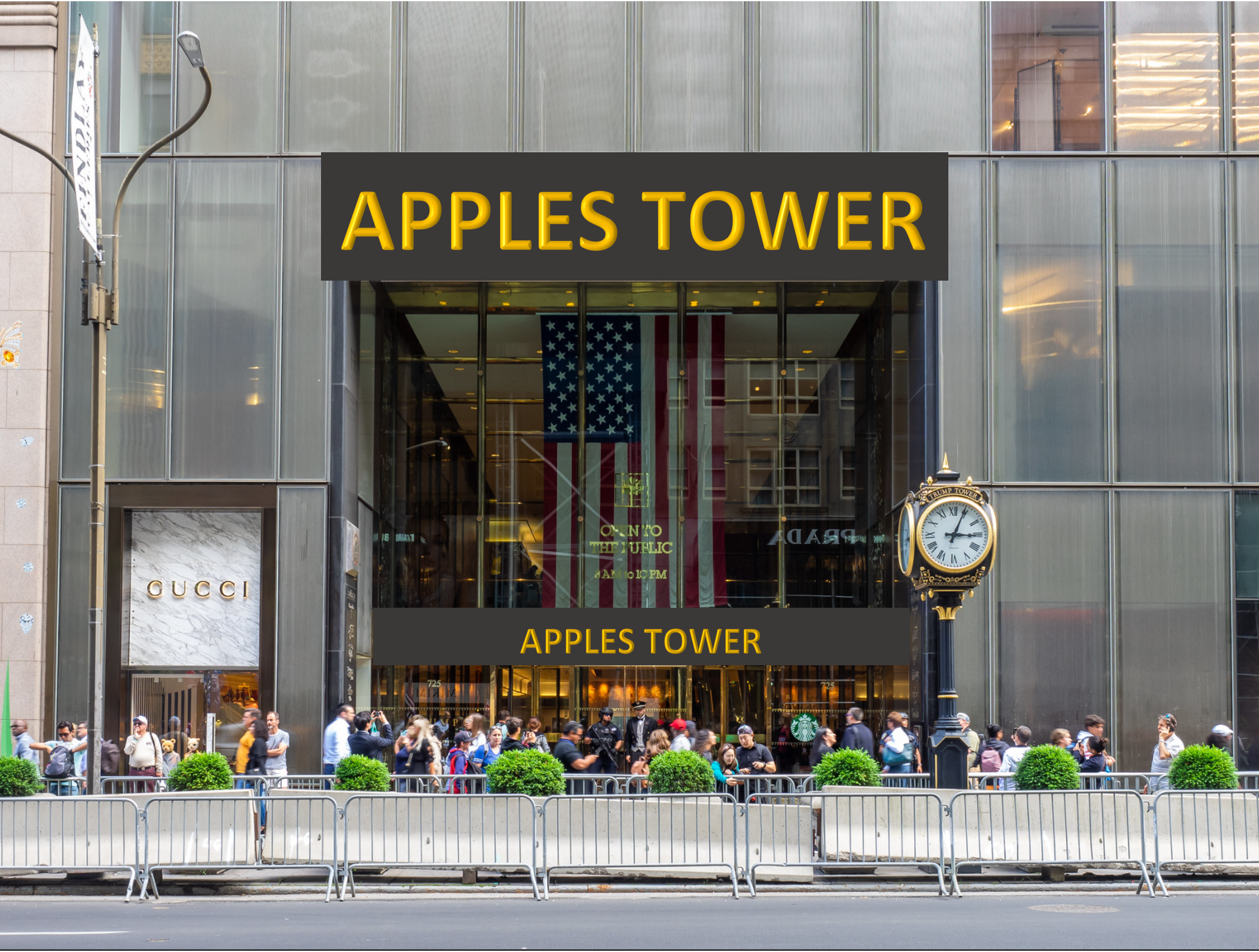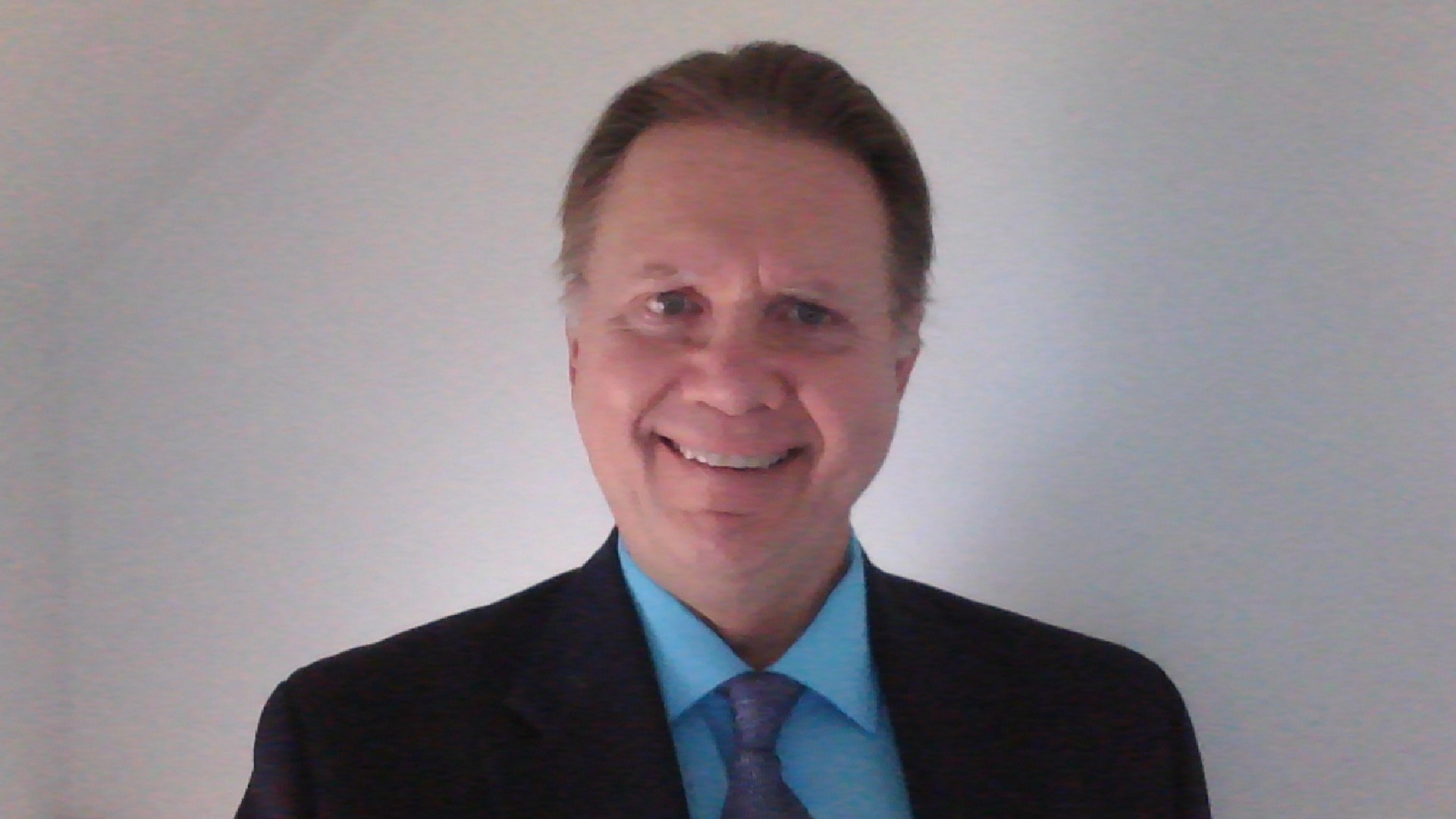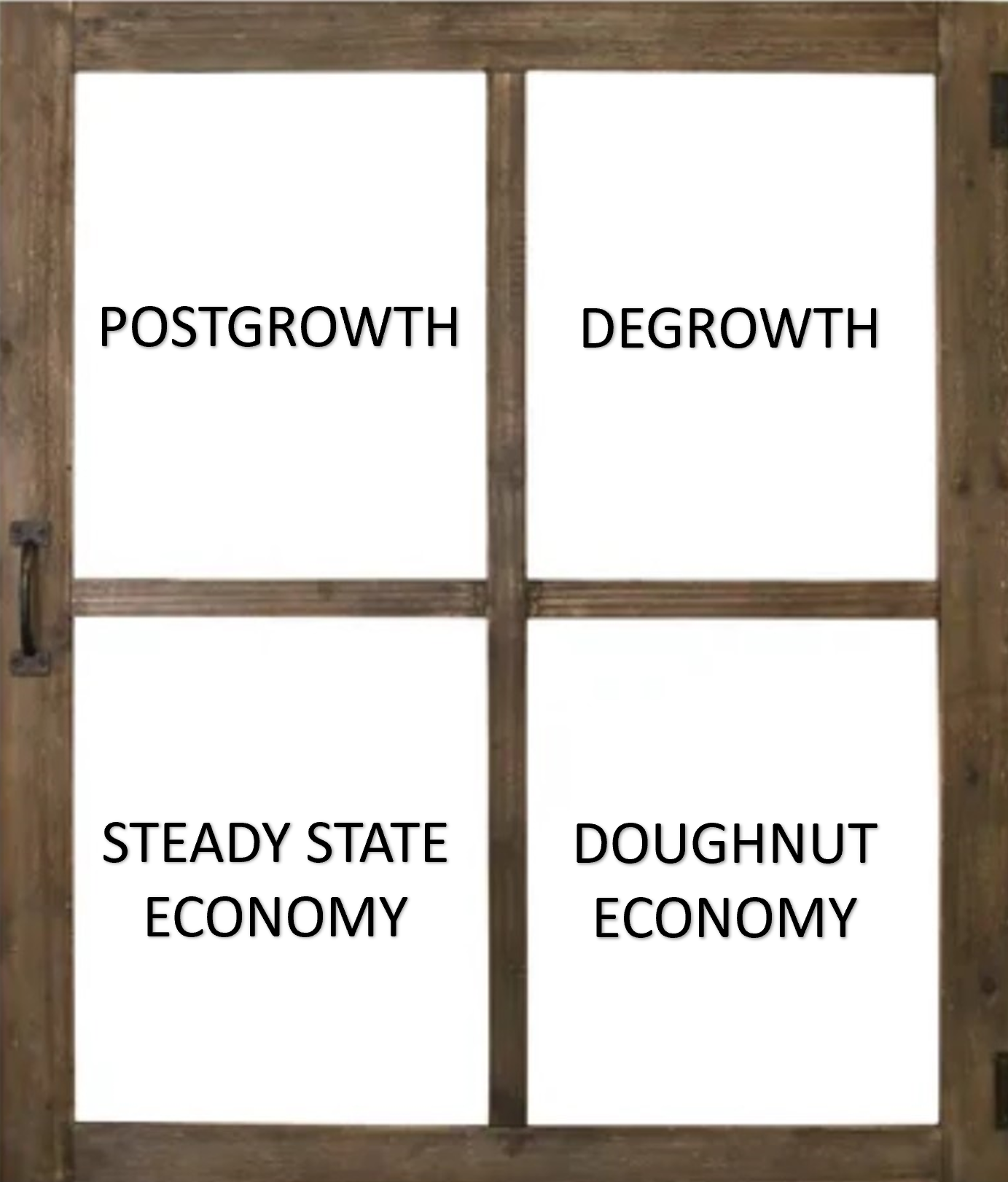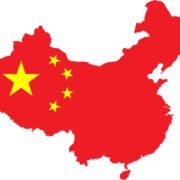Reframing the Debate: It’s the (Steady State) Economy, Stupid
by Brian Czech
May I offer you a pet peeve to chew on? I’m willing to share one for our mutual displeasure.
Here it is: Being told by academics and activists—nary a political expert among them—that “it doesn’t matter what you call it, as long as we’re all after the same thing.” With the possible exception of Donald Trump’s lips, nothing could be further from the truth. If common sense doesn’t suffice to illuminate the importance of name recognition, framing, and branding, then perhaps a mini-lesson in political science will.
Poli Sci 101 tells us that name recognition is important to political success. Maybe that’s not a good thing. Maybe it’s not fair that an arrogant sociopath, rich enough to display her name on towers and casinos and plazas, has such an advantage at the ballot box. Maybe the world would be better off if we could call whomever “Whomever” and whatever “Whatever.”

“Apples Tower?” No, not really. (CC BY 2.0, Ajay Suresh.)
But that’s not how the world works, so let’s get beyond the wishful thinking and handle the truth. As the old lottery ad went, “Wanna win? Gotta play!” If we want to win the political game, we have to play by the rules of reality.
Names aren’t just of people, either. Names apply to policies and programs every bit as importantly, if not more so. Unlike people, policies don’t have faces that instantly make long-lasting impressions, helping with recognition and remembrance. For policies, then, the name alone can make all the difference. Think “social security,” “freedom of information,” and “no child left behind.”
When you stop to think about it, how else would the political world work?
Doesn’t Matter What You Call It? A Thought Experiment
A good friend, colleague, and Ph.D. economist has told me for almost two decades that CASSE has done more to advance the steady state economy than any other entity. I say “thank you” and point out that, in addition to sound science and common sense, we have one major ally: name recognition. We consistently, persistently use the term “steady state economy” in communicating our goal.
My Ph.D. minor in political science, I tell him, reinforced for me the importance of name recognition. Find the right label, define it, and apply it relentlessly. Political strategists getting millions of dollars for framing debates follow this principle religiously. A closely related concept is “branding.”
Yet the exact same friend insists that it doesn’t matter what we call the steady state economy, as long as those advancing it are striving for an economy that fits within planetary boundaries. He tells me he has come to this “conclusion,” but with no real argument (much less data) to support such a notion. It’s just a “sense” he has.
With all due respect, I sense something too; namely a faulty assessment.
Let’s run a thought experiment. Let’s try to get my friend elected to Congress. Let’s campaign for him while respecting his “conclusion” that it doesn’t matter what we call him. Instead of resorting to the old-fashioned approach of using the surname from his birth certificate, let’s just call him “Apples.” Lots of people like apples, so that puts us in positive territory, right? “Think positive. Vote for Apples!”
Pay no heed to the fact that none of his earlier network knew him as “Apples.” We’re still talking about the same guy, so it doesn’t matter.
Next, we loudly campaign for Apples. Here come the “Apples for Congress!” buttons, “Apples for Congress!” stickers, “Apples for Congress” signs.
Unfortunately, the paraphernalia won’t do much good, because others will be using another name for our friend: namely, “Bananas.” That’s the handle preferred by a faction who want to be associated with the winning ticket, but don’t want others (namely, those preferring the name “Apples”) to be likewise acknowledged.

Pick a name; any name. “It doesn’t really matter.” (CC0 1.0, Almeidah Almeidah.)
But heck, it doesn’t matter, right? Apples, Bananas, Peaches, Hazelnut…any name works if we’re talking about this same fellow. At least, that’s his contention!
Why not just call him a different name in each new venue? “Finnishinski” might work at the Tuesday townhall meeting; “Vishwanath” should be fine for the Rotary Club on Wednesday. Then, for the weekend panel discussion, he’ll be “The Politician Formerly Known as Vishwanath, or Even More Formerly (by some at least), Hazelnut.”
Furthermore, why should it matter what anyone calls him, ever? Let’s just have each individual voter decide what they want to call him. Each vote will necessarily be a write-in, then. The collection might include the likes of (among many others) Pesketeer, Dunk, Ӂ, Kszvscvescz, and Generalisimo. You see, it just doesn’t matter what we call him; it’s always that same fellow.
Wow, that worked fabulously, didn’t it? Drumroll, please, as we wait forever to interpret the tally. I’m sure our man won with flying colors. Not the election, of course, but the Most Futile Campaign of All Time award.
Congratulations, Clesterfiddle!
Reasons to Call it the “Steady State Economy”
I’ve defined “steady state economy” for three encyclopedias, most thoroughly in the Encyclopedia of Earth. Here, however, I’ll focus on the linguistic and rhetorical properties of the phrase that make it a conceivable winner in the 21st century policy arena.
The phrase steady state economy is like a two-meaning entry in the dictionary. However, unlike the two unrelated meanings of the noun “bat,” for example, the two meanings of “steady state economy” are closely related, complementary, and entirely congruent. To wit, they are:
1) A political (state) economy that is stable in size, rather than growing or receding.
2) An economy in a stable condition of physical and biological inputs and outputs; stabilized “throughput” in other words.
In the second entry above, “stable” means the flow of throughput is non-growing and non-declining in the long run, but rather fluctuating and sustainable for a long and relevant period of time. “Relevant,” as in policy-relevant, means not unto infinity, but long enough for posterity’s purposes.
A major advantage to the phrase “steady state economy” is that the meaning—in both senses noted above—is self-evident. “Steady” is purely vernacular. So is “economy.” “State” has two primary applications (physical state and political state), and each one works smoothly in “steady state economy.”
When specifying the physical aspect, we hyphenate “steady-state economy,” because two-word adjectives are properly hyphenated. However, for the political steady state economy, hyphenation is not appropriate, because “state” modifies economy while “steady” modifies state economy. Given that a (political) steady state economy entails a (biophysical) steady-state economy, we can cover both bases with the unhyphenated “steady state economy.”
Although the linguistic minutiae require a bit of elaboration, the phrase “steady state economy” works perfectly in policy circles and even among a general public. I state this with confidence gleaned from a very high sample size, but it should come as no surprise. After all, and especially with any context to speak of, what else (beyond stable size) could reasonably be connoted with the phrase? How else could the phrase be interpreted?
As workable as the linguistics of “steady state economy” are, the rhetorical properties are even better. In a world destabilized by global heating, water shortages, resource wars, and so many other stressors in the age of limits, supply shock, and collapse, the word “steady” becomes ever more precious, desirable, and hoped for. A steady state—physical and political—is a welcome vision in a world rife with deterioration, doubt, and dissension.
And then, if the steadiness of the state applies all the way to the economy? Well, don’t forget one of the most famous political brands of all time: “It’s the economy, stupid!”
Linguistic and Rhetorical Unification
Steady staters including myself are perfectly happy with complementary non-growth names and brands such as “postgrowth,” “degrowth,” and “doughnut economy.” Each has it’s time, place, and most appropriate context. We use these terms frequently and prominently, especially “degrowth toward a steady state economy.”
Unfortunately, however, many postgrowthers, degrowthers, and doughnut economists don’t seem to reciprocate. For most, it’s probably an innocent oversight. Some are still getting their feet wet, and haven’t yet encountered the steady-state literature or community.
Perhaps there is also a faction that intentionally avoids the “steady state” term. If such a faction were prominent, the first two scenarios (innocent oversight and lack of steady-state familiarity) would be more common than they should be. It’s like Apples being called Bananas, or not being identified at all, leaving voters in the dark.
I’ll never forget the 2010 conference of the National Council for Science and the Environment. Serving on the planning committee, I helped to steer the focus toward ecological macroeconomics. During one of the panel sessions, the moderator led the panel into envisioning a sustainable, equitable economy. Finally, he asked the panel members, “What would we call such an economy?”
Out in the middle of the audience, myself and Rob Dietz (CASSE’s executive director at the time) were instantly energized, if not ebullient, because surely the “steady state economy” was about to be named and framed as exactly what we’d call such an economy. After all, the moderator was a long-time editor of Ecological Economics, and another panel member was a well-known sustainability thinker and CASSE contact. The “steady state economy” was about to be branded live and on stage among a thousand scholars, journalists, policy wonks, philanthropists, and political appointees.
The steady state economy—real sustainability—was set to take a significant step into the Washington, DC dialog. Big Green would never be the same; even Congress would start feeling the ripples.
To our utter dismay, the panel failed us all: steady staters, degrowthers, and doughnut economists alike. As I recall, “green” may have been bandied about a bit, to the rolling of eyes and borderline snoring. It was perhaps the oddest moment I’d ever experienced at a conference. I knew fully well “steady state economy” was firmly in the lexicon of the moderator, for I’d spoken with him at length about it. I ultimately concluded (as colleagues did in other venues, I came to learn) that this fearless “leader” had a fatal flaw: He couldn’t abide the leadership of others, presumably Herman Daly in this case, who was on the program for the Council’s Lifetime Achievement Award, and precisely for his work in advancing the steady state economy. For the moderator, apparently, it was either his frame—with him in the middle—or no frame at all.
We humans can’t afford such arrogance; not to the level where it impacts the entire sustainability movement. Those of us fighting the formidable forces of growth, especially, have to band together and start producing some synergistic effects, before all the water goes under the bridge. When the proverbial panel is asked, “What would we call such an economy?,” we need to be crystal clear with our framing:
- In a postgrowth world, we’ll have two basic options: degrowth or a steady state economy. And the fact is, we’ll need them both in stages. Because we’ve liquidated so many natural capital stocks, and destroyed so many funds of ecosystem services, we’ve got to shrink the economy before we can get it back to a sustainable level for a long-term steady state.
- If we can’t manage the political fortitude to shrink it voluntarily, we need, at least, to let it degrow naturally enough, without pulling out all the stops for GDP growth. After a stage of degrowth, the goal will be a steady state economy of mildly fluctuating GDP, preferably around an optimal level.
- Some may want to call the steady state a “doughnut economy,” but let’s be careful with the recipe. We’ll need to do better than the “agnosticism” about growth (as called for in Doughnut Economics). There’s no room for agnosticism in the ecological foxhole we’ve dug ourselves. We positively need degrowth toward a steady state economy.
Toward the end of the 2010 conference, with Daly winning the Lifetime Achievement Award, the audience was edified by an entirely different type of leadership than found in the earlier panel. In his acceptance speech, Daly reflected, “Blessed are they who encourage others.”
Amen!
 Brian Czech is the executive director at CASSE.
Brian Czech is the executive director at CASSE.








Personally I think it doesn’t matter what you call steady state so long as its goal and definition are explained concisely and clearly! as “an economy that fits within planetary boundaries”
Recognition, framing and branding – We see “sustainable” used in a way that has nothing to do with sustainability! So clearly using definitions rests in the way it is perceived and sold and less on “unified meaning”… If “sustainable” was forced to define itself – we would also see it often conceived as growth economy.
Thus sayeth “N.”
I’ve seen many well intentioned groups fragment over the kind of inflexibility being displayed… you don’t control the definition of words only the intention.
I tend to agree about the fragmentation problem. That said, I don’t think we’re the inflexible ones, certainly not unreasonably so. We shoot for optimum flexibility. As I described, we’ve readily adopted and adapted to the newer phraseology of postgrowth, degrowth, and doughnut economics. The article is largely about the importance of framing, and partly about the lack of flexibility found in other circles. You might consider providing your input there. Thanks in advance!
Branding is critical- Once chosen the name must be repeated as often as possible. Descriptions serve there purpose… beneath the brand name. People recognise brands- just go and walk down a supermarket aisle.
there is also confusion over the use of steady state
neoclassical economists they will use the term steady
state but they’ll say steady state growth and what they mean by steady
state growth is a constant ratio between the stock of capital and the population so that both are conceived to be growing absolutely but the ratio between them stays the same and that’s what they consider a steady state. So to avoid ambiguity there is really no point in keeping the term steady state for branding reasons.
That’s a reasonable point about the use of “steady-state economy” in neoclassical economics. I covered this in Supply Shock and in my definition of “steady state economy” at https://editors.eol.org/eoearth/wiki/Steady_state_economy , where I stated:
“The size of an economy may undergo one of two trends: growth or recession. Otherwise it is stable, in which case it is a “steady state economy.” As with many phrases, however, different connotations may apply in different contexts. In neoclassical economics, the hyphenated phrase “steady-state economy” is used to refer to an economy with steady ratios of capital:labor. Therefore, in neoclassical economics, a steady-state economy may be growing, receding, or stable, in which case it constitutes the steady state economy of ecological economics. Sometimes, however, the hyphenated “steady-state economy” is also used in the ecologically economic sense of a non-growing, non-receding economy. (In some cases this reflects the editorial style and tradition of a particular journal.) This linguistic inconsistency is not a major communications problem in broad circles because the neoclassical “steady-state economy” is a relatively abstruse concept used primarily within the jargon of neoclassical economics, whereas the ecological “steady state economy” is a technically simpler concept and has achieved a certain amount of vernacular status.
I’d largely agree that framing is important, It will what clarifies the concept…Which is why I think it doesn’t matter what you call “steady state”… with or without hyphens, So long as its goal and definition are explained concisely and clearly, this will weed out others that will use steady state in other counter productive ways… (capital and the population ratio grow at the same rate)
Any group that is hoping for “an economy that fits within planetary boundaries” should be an ally! SteadyState really it needs a much sexier name that really encompasses the aim/intention, something standalone that can’t be used by opposing forces (Wikipedia for example muddy the Steady state “brand” and concept, Jstor.org for example)
Because of widespread use in both ways of thinking, steady state is not a complete definition until the rates of throughput are clarified! and only then do you know if it is aiming at an economy that fits within planetary boundaries or not…
I think Brian’s right, the steady state economy does need to be a like brand concept. People buy into a brand, and associate themselves with it. Its like the old human nature of belonging to a tribe, Trump, Levis Gucci Dodge Tesla Apple, tag names for tribes that people associate themselves with to spectacular success.
Donald knows this.
Now, to be fair, Steady State Economy isn’t catchy like the other one word brands that work well, but for an ideal, it says what it is and packages the concept well.
That said, Its not very enticing for mass buy in. maybe improve it, STEADY-STATE, Economy that cares.
Might attract more support
Thanks, Brian. You are in fine form with this piece!
Yes, agreed, brand recognition is vital. While ‘steady-state’ needs some elaboration for newcomers, it is probably the best available short descriptor for what we are on about, and indeed what is required for true long-term sustainability.
While we might hope that the term already had better recognition, the consequent required action is not to change it but for all of us to promote strongly the term and the concept.
As an aside, on balance I think it is good that the ‘doughnut economy’ has achieved some prominence, as it does draw attention to physical limits to growth. Nonetheless, it does grate when those on the periphery, particularly journalists, give greater primacy to Raworth’s flawed concept than to the thoroughgoing solution, the steady-state economy.
Yes, and there is some… let’s call it ‘interesting confusion’ in Kate’s approach. As I mentioned in a previous article, I think she is ‘more agnostic about being agnostic’ than she is agnostic about growth. That’s the sense I got from hosting her on the Steady Stater podcast, too. I think her pitch for acting agnostic about growth has more to do with her sense of political feasibility than technical merit. And of course we don’t agree with that approach. Our approach is more straightforward, and damn the political torpedoes. We want to hammer home the truth about limits to growth—of stuff, value, and yes GDP—until the polity is on board with a steady state economy.
Agreed. It was weird that Raworth spent most of her book prosecuting the case against growth and then suddenly becomes weak-kneed at the end. Very strange.
Consistency is important, I fully agree.
All I can add to Brian’s excellent piece is something I heard from a very slick marketing person years ago: in the mind of a typical person, familiarity is the foundational layer of building a trustworthy brand.
It sounds a bit silly, but this principal (familiarity = trust) is actually the reason that big name food and drink franchises are successful. Even if individuals have no experience with Starbucks coffee, they recognize the name, and are more inclined (say the marketers) to step inside one day.
I suppose one could say it goes like this: familiarity –> trust –> acceptance
A mild correction to my post. After thinking about how marketing people do things, I think the sequence to bear in mind is this:
repetition –> familiarity –> trust –> acceptance
So I would say it’s definitely preferable to stay on message, with consistent use of the term “steady state economy.”
Perhaps something we can learn from Kate Raworth is the need to create pleasant visual imagery around the steady state brand. A doughnut is easy to imagine & very desirable. A steady state economy – “committed to operating within ecological limits” is brain food. There is an old saying in politics “reach for the heart not the head”- somehow we need to think about how to move beyond raw ecology & economics & into smarter, more emotive marketing if we want to connect with the mass market. Lets make it fun!
I tend to agree, but with the following qualifiers:
1) I think “steady” is rapidly becoming a cherished condition. Those who’ve known it truly miss stability. In the age of Supply Shock, limits to growth, the Anthropocene, global heating, etc., there’s a real longing for steadiness and stability. Therefore, I believe “steady” does reach the heart.
2) “Toddler” and “Valentine” and “Forrest Gump” might reach the heart more than “steady state economy,” but they don’t explain in one phrase precisely what we are communicating. No books or diagrams are essential for explaining the term “steady state economy”. As for the “doughnut” metaphor and label, we do like having it in the mix, but see the framing next to the “window frame” in the article.
Here’s an encouraging bit on what labels are understood: the British Medical Journal (pretty big fish, according to my wife, a US physician) summarized late last year an article about “Health in the Anthropocene”:
https://www.bmj.com/content/371/bmj.m4168
In Box 1 in the article they do their best to describe 3 alternatives: green growth, *steady state economy*, and degrowth. Overall I think they got the descriptions right, cutting the BMJ some slack. What’s reassuring is they seemed to understand and use the label “steady state economy”, as they should. We’re almost respectable now :)
A fine linguistic analysis and argument, Brian. I agree that “steady state economy” is a good brand name. But there is more that stands in the way of SSE becoming a household concept. I fear that, when people get a bit more into it, they will conjure up a static world where nothing can change because the government forbids it. That does not appeal. People want to try to improve their station in life, winning or failing. Change is a constant.
As long as the population of a given area increases, there is a degree of built-in growth, even in rich countries.
Poor countries surely have a right to increase their standard of living.
So what “constant throughput” means in actual practice ought to be made more explicit.
“How” is the hard question.